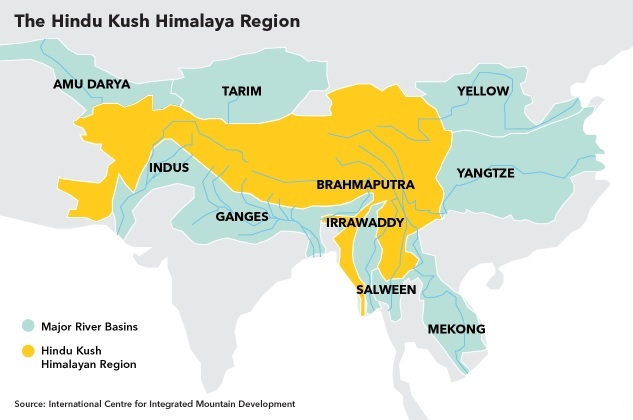-
Q. Examine the Himalayas' role as the 'Water Tower of Asia' and its impact on the regional climate and biodiversity of the Indian subcontinent. (250 words)
06 May, 2024 GS Paper 1 GeographyApproach
- Introduce the answer with a emphasis on Hindu Kush Himalayas
- Delve into the role of himalayas as water tower of asia
- Mention impact of himalayas on regional Climate and biodiversity
- Conclude suitably.
Introduction
The Himalayas or Hindu Kush Himalaya in particular is often referred to as the 'Water Tower of Asia', playing a crucial role in shaping the regional climate and biodiversity of the Indian subcontinent as it is one of the largest volumes of ice and snow outside of the Arctic and Antarctica.
Body
Role of Himalayas as Water Tower of Asia:
- Glacial Reservoir and Release: The Himalayas hold the largest concentration of glaciers outside the polar ice of the Arctic and Antarctica.
- These glaciers act as giant natural reservoirs, storing winter snowfall (e.g Gangotri Glacier) and releasing meltwater during dry summers, feeding major rivers like the Indus, Ganges, and Brahmaputra.
- This provides a crucial and consistent source of freshwater for millions in the Indian subcontinent.
- Supporting Diverse Ecosystems: The perennial rivers fed by the Himalayas nourish a vast network of ecosystems.
- These rivers are lifelines for fertile plains (e.g, Indo-gangetic plains) and wetlands (e.g. Sundarbans mangrove forests).
- This supports a rich tapestry of flora and fauna across the subcontinent.
Impact of Himalayas on Regional Climate and Biodiversity:
- Impact on Regional Climate:
- Temperature Moderation: The Himalayas shield the Indo-Gangetic plains from the icy winds blowing from Central Asia, preventing extreme cold temperatures in the Indian subcontinent.
- In contrast, the Tibetan Plateau, located on the leeward side of the Himalayas, experiences a much harsher and drier climate due to the rain shadow effect.
- Monsoon Formation: The Himalayas play a crucial role in the formation of the Indian monsoon system.
- They force moisture-laden winds to rise, leading to condensation and heavy precipitation on the subcontinent's southern slopes.
- This seasonal phenomenon brings vital rainfall for agriculture and sustains ecosystems.
- The Western Disturbances also interact with the Himalayas, affecting precipitation patterns in northern India, Pakistan, and parts of Afghanistan.
- Localized Weather Phenomena: The complex topography of the Himalayas, with its deep valleys and gorges, creates localized weather phenomena, such as valley winds, mountain waves, and Foehn winds.
- The Brahmaputra Valley in Assam and the Kashmir Valley experience distinct microclimatic conditions due to the influence of the surrounding Himalayan ranges.
- Temperature Moderation: The Himalayas shield the Indo-Gangetic plains from the icy winds blowing from Central Asia, preventing extreme cold temperatures in the Indian subcontinent.
- Impact on Biodiversity:
- Altitudinal Zonation: The Himalayas exhibit a wide range of altitudinal zones, from tropical (e.g., Terai region) to alpine (e.g., Ladakh), supporting diverse ecosystems and species.
- The rhododendron forests in the mid-hills of Nepal and Sikkim, the alpine meadows of Gulmarg in Kashmir, and the cold deserts of Ladakh are examples of unique habitats found at different elevations.
- Endemic Species: The Himalayas are home to numerous endemic species, such as Himalayan tahr, golden langur and pygmy hog.
- Migratory Routes: The Himalayas serve as a crucial migratory corridor for species like the Demoiselle crane.
- The Kanchenjunga Biosphere Reserve is an important stopover for migratory water birds.
- Altitudinal Zonation: The Himalayas exhibit a wide range of altitudinal zones, from tropical (e.g., Terai region) to alpine (e.g., Ladakh), supporting diverse ecosystems and species.
Conclusion
The Himalayas are not merely a majestic mountain range but they are the very lifeblood of the Indian subcontinent, functioning as Asia's primary water source, climate regulator, and hub of unparalleled biodiversity. Preserving this iconic natural asset is essential not only for its beauty but also for ensuring the sustainable development and resilience of the entire region.
To get PDF version, Please click on "Print PDF" button.
Print PDF





